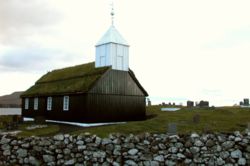Faroese wooden churches


The Faroese wooden churches ( Faroese : trækirkja , Pl. Trækirkjur ) from the 19th century are among the most architecturally important monuments of the Faroe Islands . In a narrower sense, this refers to the church buildings that were built between 1829 and 1847.
prehistory
The Faroese saga tells that Sigmundur Brestisson built a church on his home island of Skúvoy after the Faroe Islands were Christianized in 999 . The church of Sandur on the neighboring island of Sandoy is archaeologically documented and must have been built during the same period. Both were stave churches as we know them from Norway . These first evidence of Christianity after the Viking Age on the Faroe Islands are only preserved in Sandur as the foundation of today's church, while in Skúvoy only Sigmund's tombstone suggests that his church stood there.
From the time of the Catholic diocese of the Faroe Islands (approx. 1100 to 1538) only the ruins of the unfinished Magnus Cathedral (from 1300) and the Ólav Church (13th century) in Kirkjubøur have been preserved. The latter is demonstrably continuously in operation to this day and used to be the cathedral of the country. Both are stone churches. Archaeologists have also identified the Úti á Líkhúsi church . It has so far been disputed whether it is another first church from Sigmund's time or the church that was started around 1420 and was consecrated to St. Brendan . Together with the old bishopric, Kirkjubøargarður , this area forms the most historically valuable place in the Faroe Islands. Accordingly, it is on the list of candidates for UNESCO World Heritage Sites .
Stone churches have been common since the Middle Ages , and it was only later that stone walls were abandoned and only wooden buildings were built. In the forestless Faroe Islands, this is a very valuable building material that is only available as driftwood or imported goods.
Today's Tórshavner Cathedral is the second oldest intact church in the Faroe Islands. It dates from 1788 and is the oldest wooden church in the country.
Holzkirchen 1829–1847
In addition to the buildings mentioned above, the oldest preserved are the wooden churches from the period from 1829 to 1847. They are generally located in places where churches existed before, but were never able to withstand the weather for much longer than 100 years. Common features of these ten (originally 14) churches are:
- Black tarred wooden outer walls ;
- Traditional Faroese grass roof ;
- Small white church tower in the shape of a ridge , either diagonally or parallel to the roof ridge (this is how two types of these churches are distinguished);
- White painted base made of natural stone (exception: Church of Sandur without base);
- Interior made of untreated or stained wood;
- Rood screen between the choir and nave , decorated with elaborate carvings ;
- Carvings on the beams, walls and benches. The rest of the decoration in these churches is simple.
This was preceded by a relative improvement in the Faroese economy, so that new church buildings were possible. The wooden churches of this time were built by local carpenters or boat builders . All carvings are from them. They are therefore an expression of the folk art of that time .
The oldest church of this type is in Hvalvík (1829). It was built by the builder Joen Michelsen from Velbastaður , who was also involved in the other churches of the era and is famous for it in the Faroe Islands.
The other nine Faeroese wooden churches are (with consecration dates):
- Gøta (1833)
- Strendur (1834)
- Kaldbak (1835)
- Kollafjørður (1837)
- Oyndarfjørður (1838)
- Sandur (1839)
- Nes (1843)
- Porkeri (1847)
- Funningur (1847)
The current Danish travel guide Turen går til Færørne (2005) writes:
- The churches used to be open to the public, but tourists who grabbed at everything have put an end to it. If you want to see the inside of a Faroese church, you can attend the service, which takes place on Sundays at 11am or 12pm. Another possibility is to ask locally who has the key and show you the church.
- Photos of the old wooden churches
Hvalvík 1829
Gøta 1833
Kaldbak 1835
Kollafjørður 1837
Oyndarfjørður 1838
Nes 1843
Porkeri 1847
Funningur 1847
See also
List of church buildings in the Faroe Islands
literature
- Sverri Dahl: Timber Churches of the Faroes , in: Faroe Isles Review , Vol. 1, No. 2, 1976
- Rainer H. Schmeissner: Churches, crosses and runes on the Faroe Islands , studio print, Regensburg 1979 ISBN 3-922371-00-0
-
Jákup Pauli Gregoriussen : Kirkjurnar í Føroyum . in Faroese in four volumes. The author has illustrated the books richly (award-winning standard work)
- Gomlu trækirkjurnar . Velbastað: Forlagið í Støplum, 1995 ISBN 99918-914-0-4 (227 pages about the old wooden churches) Info
- Eldru hválvkirkjurnar . Velbastað: Forlagið í Støplum, 1997 ISBN 99918-914-1-2 (308 pp. On the older vaulted churches; English summary The Old Vaulted Churches , pp. 306–308) Info
- Yngru hválvkirkjurnar . Velbastað: Forlagið í Støplum, 1998. ISBN 99918-914-2-0 (316 pp. On the younger vaulted churches; English summary The New Vaulted Churches , pp. 314-316) Info
- Nýggjaru kirkjurnar . Velbastað: Forlagið í Støplum, 1999 ISBN 99918-914-3-9 (326 p. On the newer churches; English summary Modern Churches in Faroe , p. 324–326) Info
- Steen Ulrik Johannessen: Turen går til Færøerne , 5th edition. Copenhagen: Politikens Forlag 2005 ISBN 87-567-7087-1 (in Danish, 108 pages, general, detailed travel guide)
Web links
- Folkakirkjan.fo (Official website of the Faroese People's Church in Faroese. There you will find the pages of the individual churches with photos under Kirkjur og kirkjuráð )











